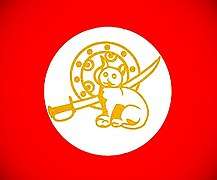Ratnadhwajpal
| Ratnadhawajpal | |
|---|---|
| Gaurinarayan | |
| Reign | 1210 - 1250 |
| Coronation | 1210 |
| Predecessor | Birpal |
| Successor | Vijayadhwajpal |
| House | Chutiya dynasty |
| Father | Birpal |
| Chutiya dynasty | |
|---|---|
| Part of History of Assam | |
 | |
| Rulers of the Chutiya kingdom (1187 - 1524) | |
| Birpal | 1187- 1210 |
| Ratnadhwajpal | 1210- 1250 |
| Vijayadhwajpal | 1250- 1270 |
| Vikramadhwajpal | 1270- 1285 |
| Gauradhwajpal | 1285- 1305 |
| Sankhadhwajpal | 1305- 1325 |
| Mayuradhwajpal | 1325- 1343 |
| Jayadhwajpal | 1343- 1360 |
| Karmadhwajpal | 1360- 1380 |
| Satyanarayan | 1380- 1400 |
| Laksminarayan | 1400- 1420 |
| Dharmanarayan | 1420- 1445 |
| Pratyashnarayan | 1445- 1465 |
| Yasnarayan | 1465- 1480 |
| Purnadhabnarayan | 1480- 1500 |
| Dharmadhajpal | 1500- 1522 |
| Nityapal | 1522- 1524 |
| Sutiya monarchy data | |
| |
| Peacock Flag (Royal Flag) | |
| Golden cat and sword (Coats of arms) | |
Ratnadhwajpal, was the son of Birpal and the second ruler of the Chutia Kingdom in the 13th century. He reigned for almost 40 years and was responsible for making Shaktism as a main religion of Chutia Kingdom.[1]
Considered among the most powerful kings of the Chutia dynasty, he was known for defeating the Chutia kings Bhadrasena and Nyayapal and for his expeditions of Kamatapur. In the mid 13th century, he marched to Dhaka and made friends with the Gauda ruler Khesav Sen. Both rulers exchanged the waters of Padma and Parashuram Kund. Ratandhwajpal also sent one of his sons to that country for education.[2]
In 1224, he shifted the capital of the kingdom from Swarnagiri to Ratnapur (present day Majuli) and later to erstwhile Sadiya around 1248. [3]
References
- ↑ (Prakash 2007:267)
- ↑ (Prakash 2007:267)
- ↑ (Prakash 2007:267)